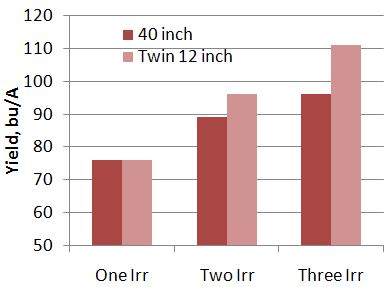
Optimizing Row Spacing for Sorghum
By Brent Bean, Ph.D., Sorghum Checkoff Agronomist
Growers often ask about the optimal row spacing for grain sorghum. As with many other agronomy-related questions, the answer is: It depends. It depends on yield potential and whether yield will be more limited by light or water.
If a grower had to choose one row spacing to best fit most environments, 30 inches would be a likely choice. A 30-inch row spacing provides a good combination of light interception and enough soil volume to provide stored water during short periods of drought. However, to maximize yield growers should choose a row spacing that is best for their growing conditions.
Wider Rows
In water-limiting environments, wider rows allow sorghum plants to use available water from a larger volume of soil. The wider rows help sorghum to survive – and even thrive – during short periods of drought. Common row spacing in these environments is 36 to 40 inches but can go as wide as 60 inches.
Growers may also use wider rows when they expect wet conditions at or around planting time. Under these conditions, a 36- to 40-inch row spacing may be beneficial, particularly when planted on beds, to allow water to drain away from planted seeds or young sorghum plants following emergence.
In some areas, growers plant sorghum in skip rows, where two 30- to 40-inch rows are planted and a third row is left unseeded. These row spacings work well when water is limiting, but skip row spacing prevents the crop from obtaining higher yields if more water becomes available during the season.
Narrower Rows
When 36- to 40-inch rows are used in high-yielding environments, planting twin rows 8 to 12 inches apart within the 36 to 40-inch configuration can be advantageous for growers. As shown in Figure 1, research demonstrated that once a 40-inch row approached 90 bushels per acre, yield was higher when planted in 12-inch twin rows.

Figure 1. Single 40-inch spaced rows versus two 12-inch twin rows. Source: Musick, USDA-ARS.

Figure 2. Comparison of 30-, 20- and 10-inch row spacings at three Kansas locations. Source: Hewitt & Dille, Kansas State University, 2015.
In environments where yield potential is consistently greater than 90 to 100 bushels per acre, growers should consider a row spacing of less than 30 inches. As shown in Figure 2, a study conducted in 2014 at three Kansas locations found that sorghum planted in 10-inch rows yielded 34 bushels per acre more than 30-inch rows in environments where the 30-inch rows yielded 100 bushels per acre or more. At Hays, Kansas, where yield potential was less than produced at the other two research locations, the 10?inch rows yielded 17 bushels per acre more than the 30-inch rows; however, researchers did not consider the difference statistically significant. Other trials have consistently shown no increase in yield when row spacing is less than 30 inches and yield potential is less than 90 to 100 bushels per acre. It is important to note that there was little difference in yield when moving from a 30 inch row to a 20 inch row. To receive a yield benefit from narrow rows, it is recommended that spacing should be no more than 15 inches.
Reduced row spacing also contributes to weed control. Narrow rows canopy quicker, reducing weed emergence and making the sorghum crop more competitive against weeds, especially Palmer amaranth. In a trial conducted by Kansas State University, when researchers did not treat a moderate population of Palmer amaranth, sorghum in 10- and 20-inch rows yielded 86 and 70 bushels per acre, respectively, compared with sorghum in 30-inch rows, which yielded only 50 bushels per acre.
Seeding Rate
In most situations, the sorghum seeding rate should remain the same on a per acre basis regardless of row spacing. Seeding rate should be based on the yield potential of the field and environment.




